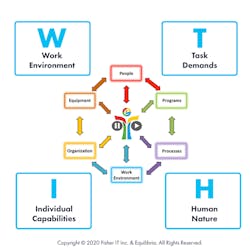Reduce Risks and Improve Organizational Effectiveness and Safety
Visual Literacy is the capacity to recognize, analyze and describe hazards as it is applied to occupational safety. Human and Organizational Performance (HOP) deploys a myriad of tools to identify and reduce risks. Used together they give EHS professionals a potent package to improve workplace safety and health. Visual Literacy and HOP share one principal: Both accept our propensity for error, often called “human fallibility.” To minimize error, both pay attention to error traps and triggers—incident precursors.
This article discusses how to identify traps and triggers, and how to control them proactively before incidents occur.
The WITH Model
Four categories make up the WITH model: Work Environment, Individual Capabilities, Task Demands, and Human Nature (see Figure 1 below). These categories are replete with error traps and incident precursors that appear on any task you may do, including:
Work Environment: General influences on task performance related to workplace, organizational and cultural conditions:
● Distractions and interruptions
● Changes and departures from routine
● Confusing displays and controls
● Identical and adjacent displays or controls
● Out-of-service warning systems
● Workarounds
● Poor condition of equipment and tools
● Poor access or equipment layout.
Individual Capabilities: Physical and emotional capabilities of an individual related to a specific task:
● Tiredness or illness
● Poor attitude or poor behavior
● Physical limitations
● Unwillingness to coach or challenge
● Unfamiliarity with the task
● Lack of knowledge
● Inexperience
● New techniques not used before.
Task Demands: Specific mental, physical, or team requirements of a task:
● Time pressure (rushing)
● High workload
● Repetitive work; monotony
● Simultaneous; multiple tasks
● Excessive communication requirements
● Confusing procedures and vague guidance; unclear standards.
Human Nature: Generic characteristics (including personality diversity combinations, aka E-Colors) of human beings that make us more vulnerable to errors under certain conditions:
● Distress
● Habit patterns
● Assumptions
● Mental shortcuts (biases)
● Fatigue
● Tunnel vision (lack of big picture)
● Boredom
● Difficulty seeing one’s own errors
● Overconfidence.
The Work Environment can be either physical (where we typically see risk) or social (two people who don’t like each other can inject other traps into the task). There needs to be a match between Individual Capabilities (the capacity of this person on this task at this time) and Task Demands (what this task requires of the individual or the team for successful completion). Human Nature (the inherent strengths and potential limiters that occur just because we are human) needs to be addressed to understand how the average human would react to the traps and precursors.
Once error traps and incident precursors are identified, a suite of error reduction (HOP) tools and techniques reduce the likelihood of these traps and precursors leading to near misses, harm, and serious injuries and fatalities.
Visual Literacy increases an individual’s skill at seeing, interpreting and communicating tasks, work environment, human nature, and individual traps and precursors before they possibly cause harm or damage.
Seeing the Whole Picture
By looking, observing and seeing with purpose and critical thinking skills, you can see individuals hampered by elements of Human Nature: limited attention spans, overconfidence, risk-taking, boredom, difficulty seeing one’s own errors, inaccurate risk perception, limited perspective, fatigue, habit patterns and limited attention caused by stress.
Seeing safety allows educated individuals to recognize co-workers confronted by Task Demands, such as rushing under time pressures; laboring under high workloads; engaged in repetitive and monotonous work; engaged in potentially dangerous multi-tasking; confused by procedures and ambiguous guidance; and possibly overwhelmed by excessive communication requirements.
Critical thinking skills of looking, observing and seeing recognize Individual Capability traps, such as individuals showing signs of being tired or ill; lacking experience or knowledge; being engaged in repetitive work leading to running on autopilot; displaying poor attitude or behaviors; going up against physical limitations, and displaying an unwillingness to be coached or speak up. Individuals need to understand when they are moving into a higher error rate, even if they are trying to critically think.
Critical thinking, without moving into a lower error rate, can still produce potential errors and events. You should watch for hearing or saying, “I think,” “I believe,” “I am pretty sure,” or “I am almost certain,” as those are the triggers that you are actually in an error rate closer to 1 in 2 than a more reasonable error rate of 1 in 100 or better. This is when critical thinking requires action to use a tool to move the error rate. Without education in Visual Literacy, you can see how easy it can be to miss these signs, triggers, error traps, and precursors. You don’t look at the broadest perspective of the work environment. You’re not watching how individuals or the environment may change over time. You’re subject to tunnel vision and your longtime work habits and biases can inhibit better situational awareness.
Visual Literacy improves our ability to recognize and identify Work Environment traps. COVE, the Center of Visual Expertise’s Seeing the Whole PICTURE, can reveal poor access or poor equipment layout, confusing displays or controls, and unexpected equipment conditions. This is accomplished by: 1) shifting your line of sight from the perimeter of the environment to the interior, enabling you to see in greater detail and with more granularity; 2) identifying contrasts and textures you previously might have missed; 3) looking at the environment from new angles or perspectives (turn it upside down); 4) double-checking what you see; taking another look (repeat); and 5) explaining, describing and communicating what you see by verbalizing out loud and reinforcing your observations and analysis.
HOP tools to address the task, work environment, human nature, and individual traps include verbalization, three-part communication (repeat and confirm instructions, for example), learning teams, facilitated improvement teams, pre-task briefings, post-task debriefings, deviation analysis, discussing work as imagined versus work as done, use of checklists, time-outs, walk-throughs, peer checks and individual checks (self-monitoring). HOP focuses on what is done correctly 99% of the time versus the 1% failure rate, eliminating vulnerabilities at critical set points in a system.
HOP pivots away from berating and disciplining individuals for errors or mistakes. HOP is centered on learning. “Tell me WHAT happened and HOW it happened.” “Tell us how the system set you up for success or failure.” “What is the highest risk task you will have to do today, and why?” “What do you need from us to be successful?”
Visual Literacy and HOP enable individuals to better understand safety as a system of interactions. Visual Literacy educates individuals to see and analyze interactions resulting in near-misses, incidents, and serious injuries and fatalities. HOP in the aggregate educates individuals to see safety as interactions between leadership, culture, processes, training, supervision, design, and more. It also enables the individual (a specific person on a specific task at a specific time) to see the risk and manage it, regardless of their position in the organization, before the risk can turn into an error or incident.
Almost all areas of a business—procurement, contractors, maintenance, operations, engineering, human resources, and senior leadership—are prone to error traps and triggers. All benefit from studying and applying both Visual Literacy and Human and Organizational Performance. Certainly, safety and health improve, as does overall organizational effectiveness.
Doug Pontsler is chairman and managing director of COVE, the Center of Visual Expertise. He was previously vice president of operations sustainability and EHS for Owens Corning. He served as a member of the National Safety Council (NSC)’s board of directors and as chairman of the NSC’s Campbell Institute. He is a recipient of NSC’s 2019 Distinguished Service to Safety Award.
Rob Fisher is president and director of operations for Fisher Improvement Technologies (FIT), a Native-American and veteran-owned business headquartered in Concord, N.C. He spent almost 10 years in the US Navy and 12 years at the South Texas Nuclear Project. Since then he has consulted for over 100 companies.
About the Author

Doug Pontsler
Doug Pontsler is chairman and managing director of COVE, the Center of Visual Expertise. He was previously vice president of operations sustainability and EHS for Owens Corning. He served as a member of the National Safety Council (NSC)’s board of directors and as chairman of the NSC’s Campbell Institute. He is a past recipient of NSC’s Distinguished Service to Safety Award.

